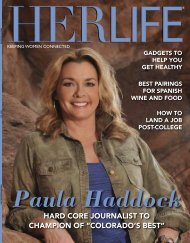Laura McIntosh - HER LIFE Magazine
Laura McIntosh - HER LIFE Magazine
Laura McIntosh - HER LIFE Magazine
You also want an ePaper? Increase the reach of your titles
YUMPU automatically turns print PDFs into web optimized ePapers that Google loves.
green livingGoing Green and What It MeansBy Candi SmithGoing green is the coolest concept going for individuals,businesses and organizations. If you proudlyproclaim you’re green-friendly, friends think you’rethoughtful, consumers think you’re working for more than thealmighty dollar and people donate to be associated with yourcause. But what does going green really mean?As explained by the website www.All-Recycling-Facts.com,“Going green means to live life, as an individual as well as acommunity, in a way that is friendly to the natural environmentand is sustainable for the Earth. It means contributing towardsmaintaining the natural ecological balance in the environment,and preserving the planet and its natural systems andresources. It also means taking steps, whether big or small, tominimize the harm you do to the environment (including thecarbon footprints you leave behind) as a result of inhabiting thisplanet.”There are five basics principles of going green, one ofwhich is to reduce pollution which releases toxic substancesinto the environment. For instance, shampoo, soaps andcleaning detergents wash chemicals down sinks and drains,which eventually make their way to rivers and reservoirs. Doyou know how many pesticides, man-made fertilizers andhormones were used to make that fast-food burger you atetoday? And let’s not discount the greenhouse gasses and toxicsubstances released into the atmosphere from the cars, bussesand cabs that transport us every day. Reduce the overall impactof pollution by switching to organic cleaners and personalgrooming products that are made from nature-based productsand are readily biodegradable. Make the switch to organicallygrown food because it’s much healthier and more nutritious.And resolve to drive less and use public transportation morebecause automobiles are, hands down, one of the largestsources of air pollution.The next green principle is to conserve resources becauseas the rate of human population continues to rise, our resourcesare not keeping up with our consumption demands. We cutdown more trees to produce paper, and extract more fossil fuelsto drive machinery and automobiles, but the planet’s supply ofoil and coal is not infinite, and we must find other resources.According to a World Wildlife Fund report, “Humans are usingmore than 20 percent more natural resources than the Earthcan produce. Between 1970 and 2000, the populations of land,freshwater and marine species have fallen by about 40 percent.At this rate, we would outstrip the Earth’s capacity to supportlife very soon.” The crux of the matter is that human beingsneed to learn to evaluate what we need (not what we want),and live within our necessary consumption needs.A third principle is to conserve energy, especially in theform of natural gas, coal and oil, and to continue exploringalternate sources of “sustainable energy” such as solar andwind energy. Conserving energy takes many forms, from turningoff lights in your home and office when not needed, drivingless and supporting manufacturers that use alternative forms ofenergy.Our fourth principle is to reduce consumption and waste,which in turn reduces pollution and conserves energy. If consumptiondecreases, so does the energy and resources neededfor production. And by reducing production, we decrease the42 <strong>HER</strong><strong>LIFE</strong>magazine.com
















